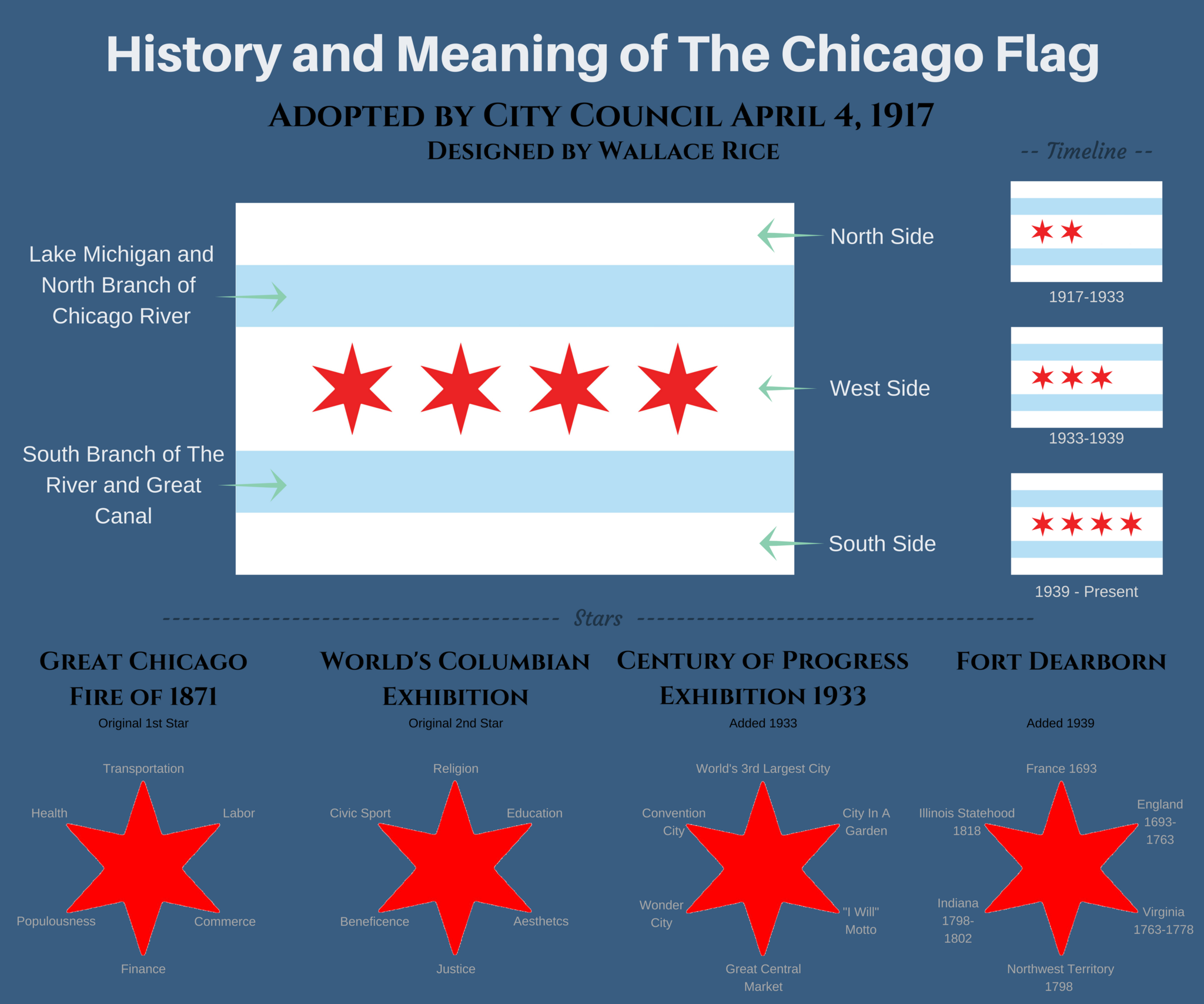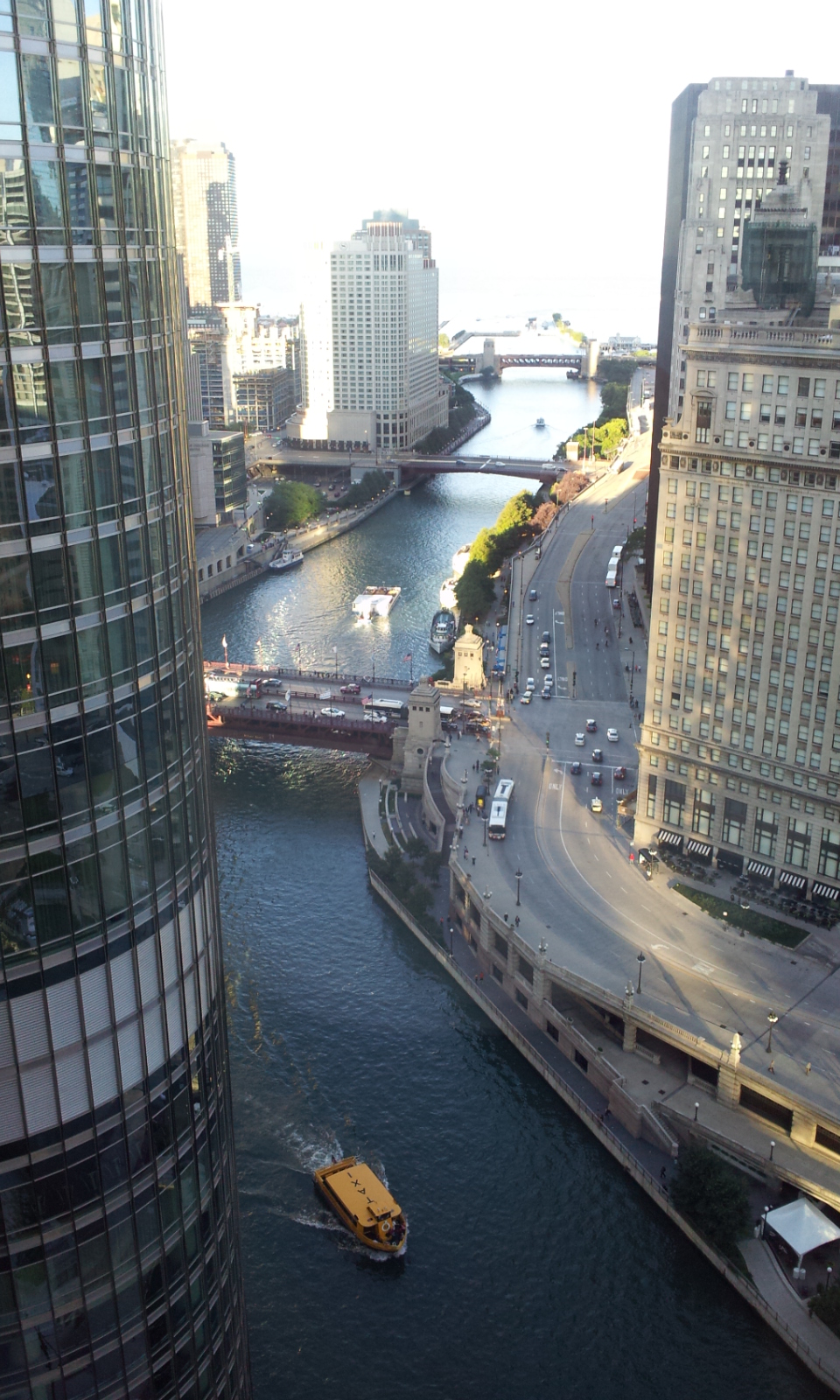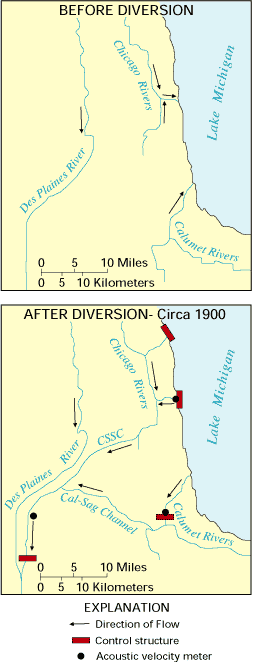|
Flag Of Chicago
The flag of Chicago consists of two light blue horizontal bars, or stripes, on a field of white, each bar one-sixth the height of the full flag, and placed slightly less than one-sixth of the way from the top and bottom. Four bright red stars, with six sharp points each, are set side by side, close together, in the middle third of the flag's surface. The City of Chicago's flag was adopted in 1917 after the design by Wallace Rice won a City Council sponsored competition. It initially had two stars until 1933, when a third was added. The four-star version has existed since 1939. The three sections of the white field and the two bars represent the geographical features of the city, the stars symbolize historical events, and the points of the stars represent important virtues or concepts. The historic events represented by the stars are the establishment of Fort Dearborn, the Great Chicago Fire of 1871, the World's Columbian Exposition of 1893, and the Century of Progress Expos ... [...More Info...] [...Related Items...] OR: [Wikipedia] [Google] [Baidu] |
Chicago Portage
The Chicago Portage was an ancient portage that connected the Great Lakes waterway system with the Mississippi River system. Connecting these two great water trails meant comparatively easy access from the mouth of the St Lawrence River on the Atlantic Ocean to the Rocky Mountains, and the Gulf of Mexico. The approximately six-mile link had been used by Native Americans for thousands of years during the Pre-Columbian era for travel and trade. In the summer of 1673 members of the Kaskaskia, a tribe of the Illinois Confederation, led French explorers Louis Jolliet and Father Jacques Marquette, the first known Europeans to explore this part of North America, to the portage. A strategic location, it became a key to European activity in the Midwest, ultimately leading to the foundation of Chicago. In 1848, the water divide was breached by the Illinois and Michigan (I&M) Canal cutting through the portage. Created by a glacier The history of the Chicago Portage begins at the e ... [...More Info...] [...Related Items...] OR: [Wikipedia] [Google] [Baidu] |
Six-pointed Star
Star polygons and polygonal compounds are the basis for numerous figures of significance in arts and culture. The figure may be the border or interior of the polygon, or one or more closed polygonal paths that include all of the border and also have some legs crossing the interior. Impressions of astronomical stars provide the term, but specific uses may exploit the connection or not. Stars often represent the unity of states within a country when they are used as a part of the flag. Emblematic use *In heraldry, a mullet is a star with straight arms and typically five points. A star with wavy rather than straight rays is called an estoile. The mullet, used as an heraldic charge, is the ensign of knightly rank, and every order of knighthood incorporates this symbol in some way. It has traditionally been used in British heraldry as a mark of cadency for the third son. *In Christian art, St. Bruno bears a star on his breast; Saint Dominic, Saint Humbert and Saint Peter of A ... [...More Info...] [...Related Items...] OR: [Wikipedia] [Google] [Baidu] |
Argent
In heraldry, argent () is the tincture of silver, and belongs to the class of light tinctures called "metals". It is very frequently depicted as white and usually considered interchangeable with it. In engravings and line drawings, regions to be tinctured ''argent'' are either left blank, or indicated with the abbreviation ''ar''. The name derives from Latin ''argentum'', translated as " silver" or "white metal". The word ''argent'' had the same meaning in Old French '' blazon'', whence it passed into the English language. In some historical depictions of coats of arms, a kind of silver leaf was applied to those parts of the device that were argent. Over time, the silver content of these depictions has tarnished and darkened. As a result, it can sometimes be difficult to distinguish regions that were intended as "argent" from those that were "sable". This leaves a false impression that the rule of tincture has been violated in cases where, when applied next to a dark col ... [...More Info...] [...Related Items...] OR: [Wikipedia] [Google] [Baidu] |
West Side, Chicago
The West Side is one of the three major sections of the city of Chicago in Cook County, Illinois, along with the North Side and the South Side. The West Side consists of communities that are of historical, cultural, and ideological importance to the history and development of Chicago. On the flag of Chicago, the West Side is represented by the central white stripe. The Chicago West Side has gone through many transitions in its ethnic and socioeconomic makeup due to its historic role as a gateway for immigrants and migrants as well as its role for funneling poorer African-American residents away from the wealthier lakeside neighborhoods and central business district. Today, the West Side consists of large mixed communities of middle class, working class, and low-income African American, Puerto Rican, and Mexican residents; some small communities of blue-collar, lower middle class and middle class white residents of historically Polish, Italian, Czech, Russian Jewish, and Gree ... [...More Info...] [...Related Items...] OR: [Wikipedia] [Google] [Baidu] |
Indiana Territory
The Indiana Territory, officially the Territory of Indiana, was created by a congressional act that President John Adams signed into law on May 7, 1800, to form an organized incorporated territory of the United States that existed from July 4, 1800, to December 11, 1816, when the remaining southeastern portion of the territory was admitted to the Union as the state of Indiana. The territory originally contained approximately of land, but its size was decreased when it was subdivided to create the Michigan Territory (1805) and the Illinois Territory (1809). The Indiana Territory was the first new territory created from lands of the Northwest Territory, which had been organized under the terms of the Northwest Ordinance of 1787. The territorial capital was the settlement around the old French fort of Vincennes on the Wabash River, until transferred to Corydon near the Ohio River in 1813. William Henry Harrison, the territory's first governor, oversaw treaty negotiations with the ... [...More Info...] [...Related Items...] OR: [Wikipedia] [Google] [Baidu] |
Northwest Territory
The Northwest Territory, also known as the Old Northwest and formally known as the Territory Northwest of the River Ohio, was formed from unorganized western territory of the United States after the American Revolutionary War. Established in 1787 by the Congress of the Confederation through the Northwest Ordinance, it was the nation's first post-colonial organized incorporated territory. At the time of its creation, the territory included all the land west of Pennsylvania, northwest of the Ohio River and east of the Mississippi River below the Great Lakes, and what later became known as the Boundary Waters. The region was ceded to the United States in the Treaty of Paris of 1783. Throughout the Revolutionary War, the region was part of the British Province of Quebec. It spanned all or large parts of six eventual U.S. states ( Ohio, Indiana, Illinois, Michigan, Wisconsin, and the northeastern part of Minnesota). Reduced to present-day Ohio, eastern Michigan and a sliver ... [...More Info...] [...Related Items...] OR: [Wikipedia] [Google] [Baidu] |
Illinois County, Virginia
Illinois County, Virginia, was a political and geographic region, part of the British Province of Quebec, claimed during the American Revolutionary War on July 4, 1778 by George Rogers Clark of the Virginia Militia, as a result of the Illinois Campaign. Though part or all of the area was also claimed by Connecticut and Massachusetts and Virginia, it was formally organized by the Commonwealth of Virginia later that year. The County was accorded official governmental existence, including legally defined boundaries and a formal governmental structure under the laws of the Commonwealth. The county seat was the old Illinois Country French village of Kaskaskia. John Todd was appointed by Governor Patrick Henry to head the county's government. The county was abolished in January 1782, and Virginia ceded the land to the new United States Confederation government in 1784. The area later became the Northwest Territory by an Act of Congress in 1787. Geographically, the county was bord ... [...More Info...] [...Related Items...] OR: [Wikipedia] [Google] [Baidu] |
Province Of Quebec (1763–1791)
The Province of Quebec (french: Province de Québec) was a colony in British North America which comprised the former French colony of Canada. It was established by the Kingdom of Great Britain in 1763, following the conquest of New France by British forces during the Seven Years' War. As part of the Treaty of Paris, France gave up its claim to the colony; it instead negotiated to keep the small profitable island of Guadeloupe. Following the Royal Proclamation of 1763, Canada was renamed the Province of Quebec, and extended from the coast of Labrador on the Atlantic Ocean, southwest through the Saint Lawrence River Valley to the Great Lakes and beyond to the confluence of the Ohio and Mississippi Rivers. Portions of its southwest, those areas south of the Great Lakes, were later ceded to the newly established United States in the Treaty of Paris (1783) at the conclusion of the American Revolution; although the British maintained a military presence there until 1796. In 179 ... [...More Info...] [...Related Items...] OR: [Wikipedia] [Google] [Baidu] |
Illinois Country
The Illinois Country (french: Pays des Illinois ; , i.e. the Illinois people)—sometimes referred to as Upper Louisiana (french: Haute-Louisiane ; es, Alta Luisiana)—was a vast region of New France claimed in the 1600s in what is now the Midwestern United States. While these names generally referred to the entire Upper Mississippi River watershed, French colonial settlement was concentrated along the Mississippi and Illinois Rivers in what is now the U.S. states of Illinois and Missouri, with outposts in Indiana. Explored in 1673 from Green Bay to the Arkansas River by the ''Canadien'' expedition of Louis Jolliet and Jacques Marquette, the area was claimed by France. It was settled primarily from the '' Pays d'en Haut'' in the context of the fur trade, and in the establishment of missions by French Catholic religious orders. Over time, the fur trade took some French to the far reaches of the Rocky Mountains, especially along the branches of the broad Missouri R ... [...More Info...] [...Related Items...] OR: [Wikipedia] [Google] [Baidu] |
Five-pointed Star
A five-pointed star (☆), geometrically an equilateral concave decagon, is a common ideogram in modern culture. Comparatively rare in classical heraldry, it was notably introduced for the flag of the United States in the Flag Act of 1777 and since has become widely used in flags. It has also become a symbol of fame or "stardom" in Western culture, among other uses. History of use Early history The Egyptian hieroglyph representing "star" had five points (N14 N14), while the "star" sign in Mesopotamian cuneiform had eight. Sopdet, the Egyptian personification of the star Sirius, is always shown with the five-pointed star hieroglyph on her head. The star (or '' mullet'') is comparatively rare in medieval heraldry, but from an early time, the five-pointed star was preferred in English and Scottish heraldry (e.g. in the Dering Roll, c. 1270), while the preferred number of points in German heraldry was six. The star in the coat of arms of the De Vere family was in legend a ... [...More Info...] [...Related Items...] OR: [Wikipedia] [Google] [Baidu] |
Kitty Kelly Holding Flag Of Chicago 201921
Kitty or Kittie may refer to: Animals * Cat, a small, domesticated carnivorous mammal ** Kitten, a young cat Film * Kitty Films, an anime production company in Japan * ''Kitty'' (1929 film), based on the Deeping novel; the first British talking picture * ''Kitty'' (1945 film), starring Paulette Goddard * ''Kitty'' (2002 film), a Kannada film starring Darshan * ''Kitty'' (2016 film), a short film written and directed by Chloe Sevigny Games and money * Kitty, in poker terminology, a pool of money built by collecting small amounts from certain pots, often used to buy refreshments, cards, and so on * Kitty, in card game terminology, additional cards dealt face down in some card games * Kitty, a colloquial term for prize money or other moneys collected by a group Music * Kittie, an all-female Canadian metal band * "Kitty" (song), by the Presidents of The United States of America * Kitty Kitty Corporation, a now-defunct English record label * "Mickey" (Toni Basil song) or ... [...More Info...] [...Related Items...] OR: [Wikipedia] [Google] [Baidu] |
Chicago Sanitary And Ship Canal
The Chicago Sanitary and Ship Canal, historically known as the Chicago Drainage Canal, is a canal system that connects the Chicago River to the Des Plaines River. It reverses the direction of the Main Stem and the South Branch of the Chicago River, which now flows out of Lake Michigan rather than into it. The related Calumet-Saganashkee Channel does the same for the Calumet River a short distance to the south, joining the Chicago canal about halfway along its route to the Des Plaines. The two provide the only navigation for ships between the Great Lakes Waterway and the Mississippi River system. The canal was in part built as a sewage treatment scheme. Prior to its opening in 1900, sewage from the city of Chicago was dumped into the Chicago River and flowed into Lake Michigan. The city's drinking water supply was (and remains) located offshore, and there were fears that the sewage could reach the intake and cause serious disease outbreaks. Since the sewer systems were alread ... [...More Info...] [...Related Items...] OR: [Wikipedia] [Google] [Baidu] |







